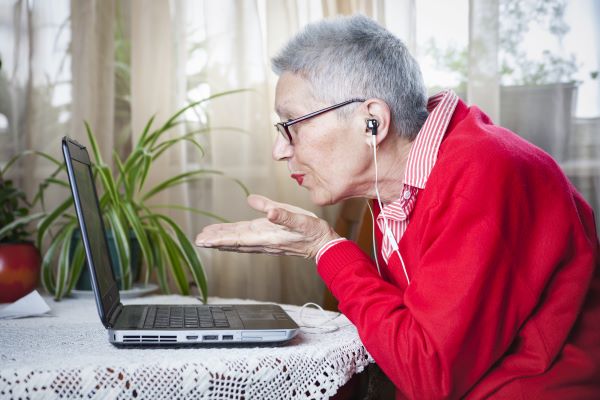How can veterans use their Department of Veterans Affairs benefits to pay for long-term care?…

What Technology Can Do to Keep Seniors Socially Engaged but Socially Distant
In order to live a successful, healthy age, we need to form connections with the people around us. The opportunities for people to laugh, move, and learn together are foundational to aging success. Enter the coronavirus pandemic to change all of that. Now aging Americans must stay socially engaged while maintaining a physical distance. This issue touches us all from senior wellness professionals, medical staff, families, inter-resident connections, and those aging in place at home and alone. The internet of things, and the virtual links it creates, are a great solution to implement in a socially distanced, troubling pandemic world.
Virtual technology tools were becoming more ubiquitous before the coronavirus. Yet, the need for emotional well-being as the especially vulnerable aging population of America became isolated was the accelerant solution to address the problem. Fitness classes ranging from tai chi to yoga and other forms of movement became available in droves of senior online classes. Connecting with family members or health professionals through telemedicine also became crucial as regular visitations and routine medical appointments became impossible.
Virtual tools provide a great advantage for social distancing as no meeting space is required. Senior interaction with tech tools has brought new learning and skills opportunities, providing a sense of connection, purpose, and pride. Older adults share their newfound prowess in video messages, multi online person chats, and more. Grandparents and grandchildren find common ground in a technological world, and grateful parents/adult children are happy for the means to address the social isolation problem and create stronger inter-generational family ties.
Beyond the connection of friends and family, technology brings email, instant messaging, social media sites, brain games, wellness bingo cards, music, even virtual cruises with daily ports of call to keep seniors connected in isolation. Many aging adults associate full-length feature films with a movie theater and do not realize they can watch nearly anything they want via streaming services, 24 hours a day, whenever they choose.
While the internet and these technology tools provide virtual interaction and entertainment, not every senior who needs it can afford a tablet computer, or laptop. Many communities are holding campaigns to raise funds for those in need of these digital devices. Nursing homes can receive a stipend from the Centers for Medicare and Medicaid (CMS) through the Civil Monetary Penalty (CMP) fund. Funding through CMP provides communication aids such as tablet devices and webcams that enable virtual visits. However, each facility has a limit of $3,000 to ensure a balance in distributing CMP funds. Because these items may be shared among negative COVID-19 residents, it is critical to avoid entering highly personal information into device applications or programs. Shared tablets are not a good way to check bank accounts, shop online, or have your senior pay bills.
Be wary of too much learning too quickly for a senior. Don’t overwhelm the aging adult with the technology, rather focus on what it provides. Slowly introduce different aspects of the technology and be certain the senior has a firm understanding of how to repeat the process to get online or risk creating frustration. Also, educating them that even though they can Skype, Zoom, et al. with others does not mean their loved ones or friends will be available at all times for them. Set a schedule for meaningful connections, managing their expectations to keep them from cycles of disappointment. Share successes, experiences, even failures with residential staff, other family members, and residents. Find out what works the best overall. Keep the strategy simple for the best results.
Be aware that seniors without strong social connections before covid-19 may feel incredibly left out. The technology connecting people doesn’t work if there is no one to communicate with on the other end of the virtual line. Residents without existing social networks typically rely on the now non-existent shared dining room and community events for interaction, and they may now be left behind. These residents need more assistance in learning how to join online classes and interactive communities that share like interests. Senior Americans unfamiliar with the internet of things do not understand the scope of what is available to them.
CMS Administrator Seema Verma states, “While we must remain steadfast in our fight to shield nursing home residents from this virus, it is becoming clear that prolonged isolation and separation from family is also taking a deadly toll on our aging loved ones.” Help your loved one to leverage digital technology and the internet to stay connected during the coronavirus pandemic. There is still hope and human connection available, and vulnerable and isolated seniors are in desperate need of both.
We hope you found this article helpful. If you’d like to discuss your particular situation, please contact our Sherwood or Searcy office at 501-834-2070 to discuss how we can help you or your loved one.



